Pixel 9 Pro vs iPhone 16 Pro: Let's take the battle to the AI grounds
We may earn a commission if you make a purchase from the links on this page.

Intro
The Pixel 9 Pro has now been official for more than half an year. After Google surprisingly announced that we'll get a bunch of new devices on August 13, things went as planned and we got four new Pixels, including the aforementioned Pixel 9 Pro. The iPhone 16 Pro also made its debut during the Apple “It’s Glowtime” event on September 9, 2024.
These two models are now maturing and exiting the honeymoon phase, so it's the perfect time for a comparison.
Will the new Pixel 9 Pro be able to challenge a well-established entity in the smartphone Pantheon such as the iPhone Pro? Today we're going to try and find out.
These two phones look very similar on paper, and they even employ similar flat-side design now. So, in order to declare a winner, we'll have to delve deeper, run some benchmarks, and snap some camera samples. Let's get to it!
Pixel 9 Pro vs iPhone 16 Pro differences:
| Pixel 9 Pro | iPhone 16 Pro |
|---|---|
| Similar size, probably a tad larger | A more compact phone |
| 6.3-inch display roughly the same size as the iPhone 16 Pro, 1-120Hz refresh rate | 6.3-inch display, ProMotion 120Hz, 1-nit minimum brightness |
| Triple camera, including a telephoto, main camera is 50MP, 48MP ultrawide, 48MP telephoto with 5x optical zoom | Similar camera system, 48MP stacked sensor for the main camera, 48MP ultrawide, tetraprism telephoto with 5x optical |
| More RAM at 16GB | Less RAM at 8GB but not that important |
| 128GB base storage | Double the base storage at 256GB |
| Larger 4,700 mAh battery that will potentially deliver better battery life | A smaller 3,582 mAh battery |
| Tensor G4, still slower than Snapdragon and Apple silicon in synthetic benchmarks | A18 Pro chipset, improved thermal design for 20% improvement in heat management and better performance |
| 45W fast wired charging, faster than what the iPhone | Slower wired charging, MagSafe wireless charging |
Table of Contents:
Design and Display Quality
Different yet similar
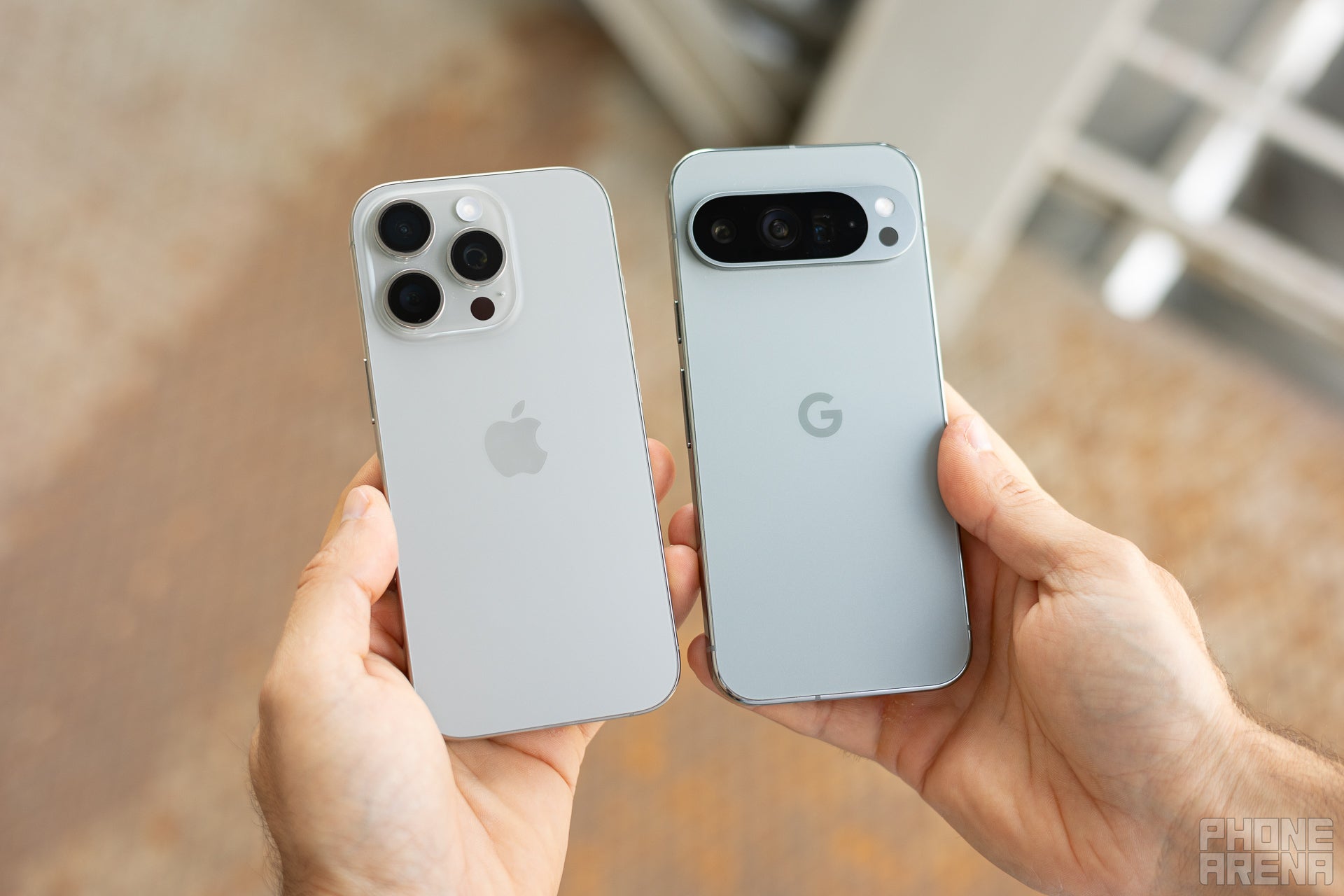
This year, the iPhone 16 Pro has grown in size, due to the 6.3-inch screen Apple slapped on the Pro model. The Google Pixel 9 Pro, on the other hand, has shrink to 6.3 inches to make room for the new addition to the lineup, the Pixel 9 Pro XL.
So, intentionally or not, these two phones ended up being very similar in size, weight, and display specs. What remains different is the design.
The Pixel 9 Pro features a reimagined camera bar on the back, the "bar" does not go all the way across the device but rather sticks out like an isle. The overall shape is different and gives the Pixel 9 Pro a different design vibe altogether. The sides are also flat, with no curvature on the front or back, which makes the Pixel feel similar to an iPhone.
So, intentionally or not, these two phones ended up being very similar in size, weight, and display specs. What remains different is the design.
The Pixel 9 Pro features a reimagined camera bar on the back, the "bar" does not go all the way across the device but rather sticks out like an isle. The overall shape is different and gives the Pixel 9 Pro a different design vibe altogether. The sides are also flat, with no curvature on the front or back, which makes the Pixel feel similar to an iPhone.
Speaking of which, the iPhone 16 Pro maintains the overall design language of its predecessors, with a square camera bump housing three lenses and a flat front, back, and sides. The iPhone 16 Pro also features a next-gen Ceramic Shield front glass, which Apple says is two times stronger than the one found on previous iPhones. The titanium trend Apple started last year is again present on the Pro models in the current generation, while the Pixel 9 Pro went down the aluminum route once again.
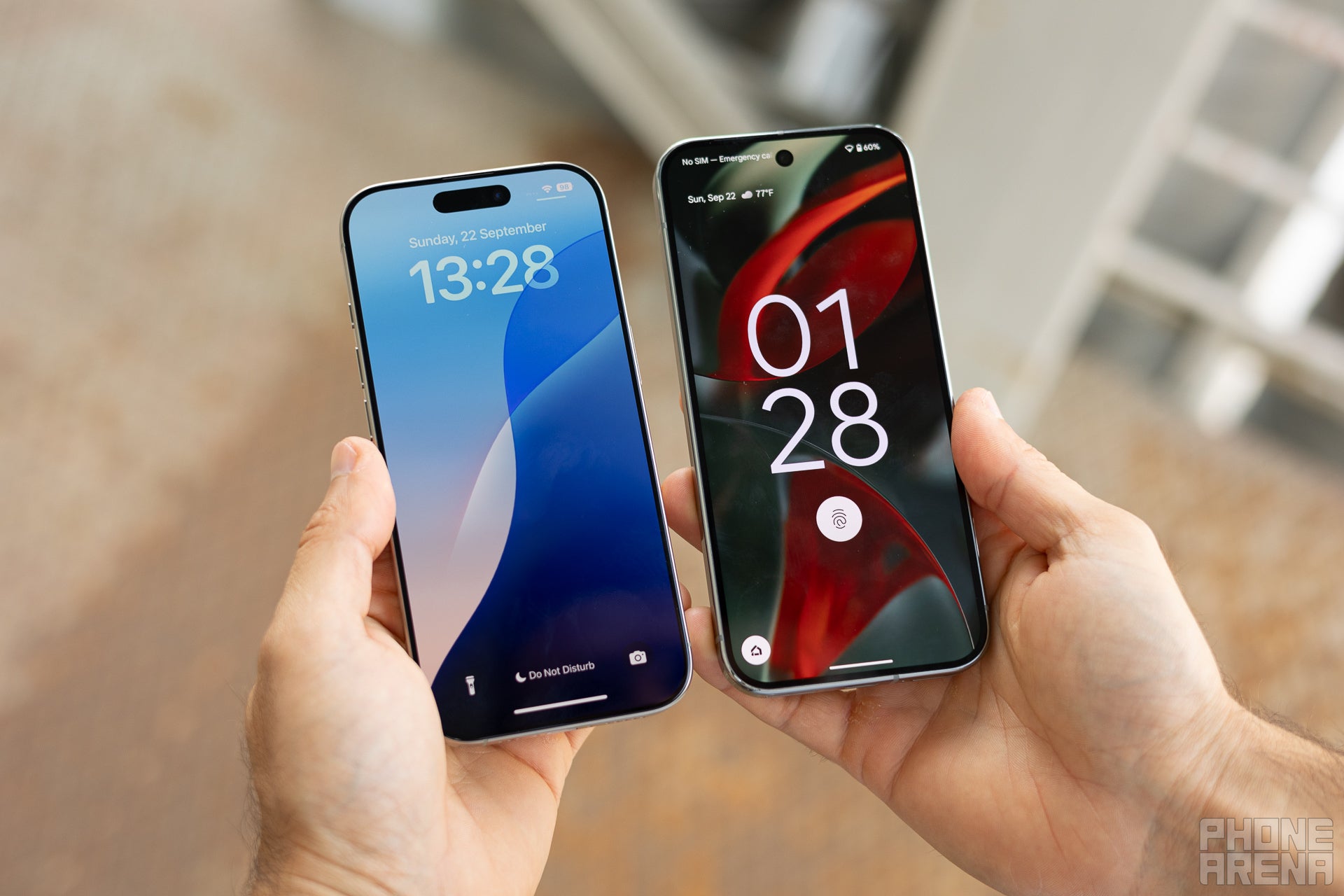
The display tech on both phones is quite similar. The iPhone 16 features an LTPO panel capable of doing a 1-120Hz dynamic refresh rate (called ProMotion in typical Apple fashion), and decent peak brightness of 2000 nits (with 1 nit minimum brightness cited by Apple).The pill-shaped cutout for the front cameras and sensors with the additional Dynamic Island functionality is still here.
The Pixel 9 Pro already set the benchmark with its 6.3-inch LTPO panel, capable of outputting 2000 nits of HDR brightness and up to 3000 nits of total peak brightness, so the iPhone 16 Pro has something to fight for here.
Display Measurements:
Looking at our display tests above, it's clear that Apple had managed to reduce the minimum brightness to the advertised 1-nit levels. However, the situation on the other side of the spectrum is rather different. The Pixel 9 Pro managed to output twice the brightness of the iPhone - 2,000 nits versus around 1,000 for the iPhone 16 Pro. The color accuracy and temperature are excellent on both phones but if you want your display to be as bright as possible, the Pixel 9 Pro is the obvious choice here.
Performance and Software
Surrender to the AI
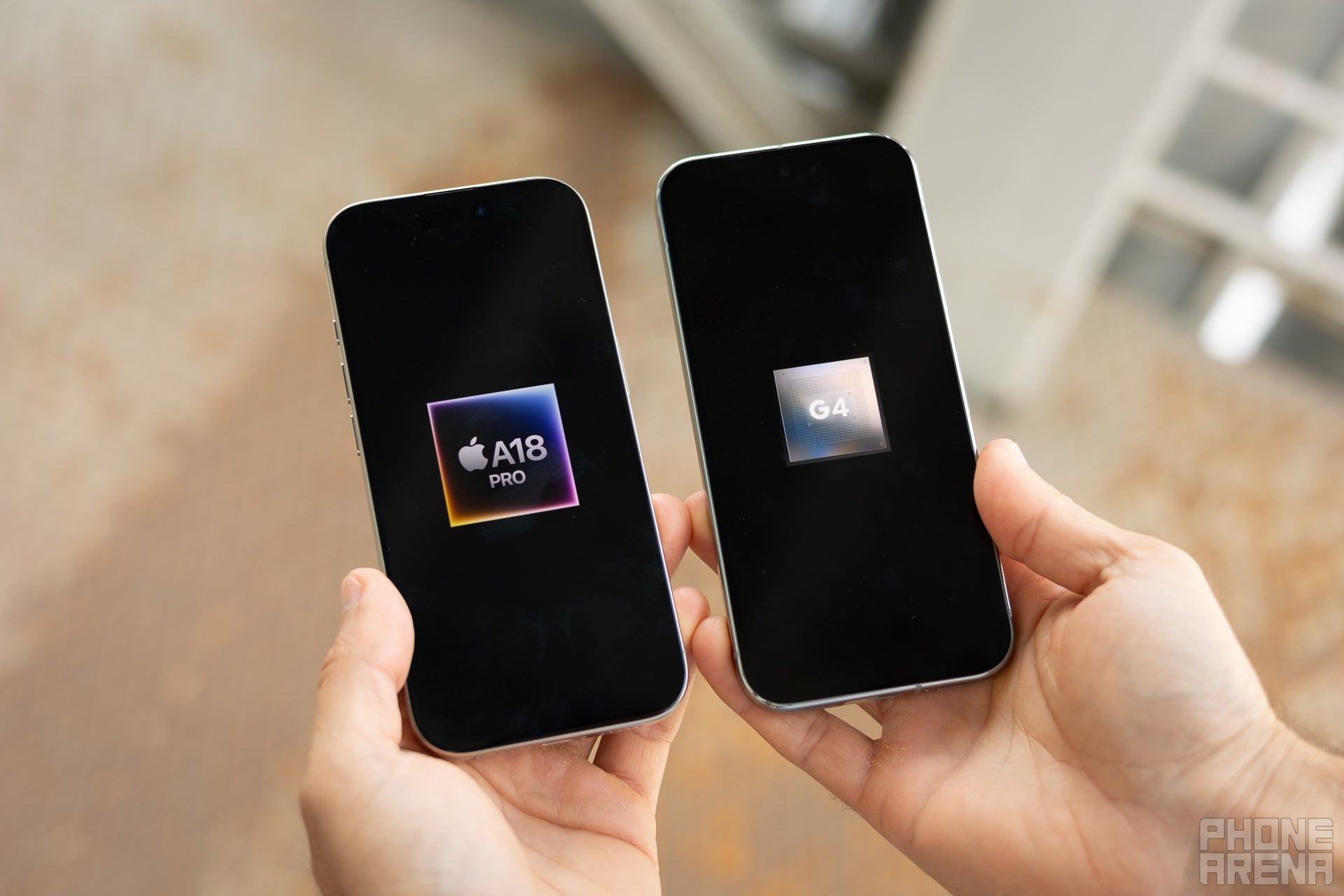
Nowadays, the hardware is starting to get more and more irrelevant when it comes to smartphones. On the one hand, we have more than enough power for day-to-day tasks, on the other hand, AI is taking over as the main driver for innovation, and it's mostly software. However you want to put it, most of the AI tasks are done in the cloud, even though big companies are trying to push through "on-device" AI as the primary way to do it.
That being said, there's still some innovation going on, and it has implications for efficiency. The iPhone 16 Pro comes with a new A18 chipset with the "Pro" moniker on it, and an improved NPU to handle some machine learning tasks. Apple has also redesigned the cooling system to offer 20% improvement in heat management and better performance under sustained load.
That being said, there's still some innovation going on, and it has implications for efficiency. The iPhone 16 Pro comes with a new A18 chipset with the "Pro" moniker on it, and an improved NPU to handle some machine learning tasks. Apple has also redesigned the cooling system to offer 20% improvement in heat management and better performance under sustained load.
The Pixel 9 Pro comes equipped with the next-gen Tensor G4 chipset. The in-house developed Google silicon is designed with machine learning performance in mind, so despite some lackluster results in synthetic benchmarks for the past generation of Tensors, the AI performance, and everyday performance in general is very similar between these two phones. That being said, if raw performance is important to you, the iPhone 16 Pro is the clear winner. The benchmarks below paint a very clear picture.
The RAM situation is again a bit hard to compare, as Android and iOS handle apps differently. In general, iPhone devices need less RAM to get the same performance, as apps are quite optimized and there's only Apple using iOS, as opposed to a huge number of brands using Android. That being said, the Pixel 9 Pro sports 16GB of RAM (probably to ensure smooth on-device AI operation), while the iPhone 16 Pro gets away with only 8GB, even though Apple made sure we understand how heavy the company is invested in AI or Apple Intelligence as we're to use the hijacked term.
It's also worth mentioning that both of these phones support Wi-Fi 7, the latest standard in wireless information transfer. You can read more about it in our dedicated article.
Apple announced some really cool AI features during the "It's Glowtime" event, including Visual Intelligence (Google Lens more or less), Photographic Styles, which are AI-based, and also Audio Mix Styles. The sad part about it is that all these features will arrive later IN BETA, and we don't know when exactly they'll be finalized and ready.
UPDATE: There's a new iOS version! iOS 26 has landed not only with a brand-new naming scheme but also with a lot of new features and one of the biggest design changes in the past couple of years.
Enter Liquid Glass. The new design features a lot of polished "glassy" visual elements and also transparency. There's also a new dynamic wallpaper option that adapts the lock screen and wallpaper to fit incoming notifications.
There's a new security feature called Call Screening—it monitors calls and alerts you about any suspicious callers, such as scammers and telemarketers. This also works in Messages, so your chats will be free of spam, too.
Speaking of Messages, the app has been improved with the ability to set custom backgrounds, start polls in group chats, and new typing indicators.
Apple Maps has also been improved and should be smarter. It will monitor your commutes and proactively suggest routes that avoid traffic or other mishaps along the trip. You can check out a full breakdown of all the new iOS 26 features in our dedicated article.
Camera
Closer than ever
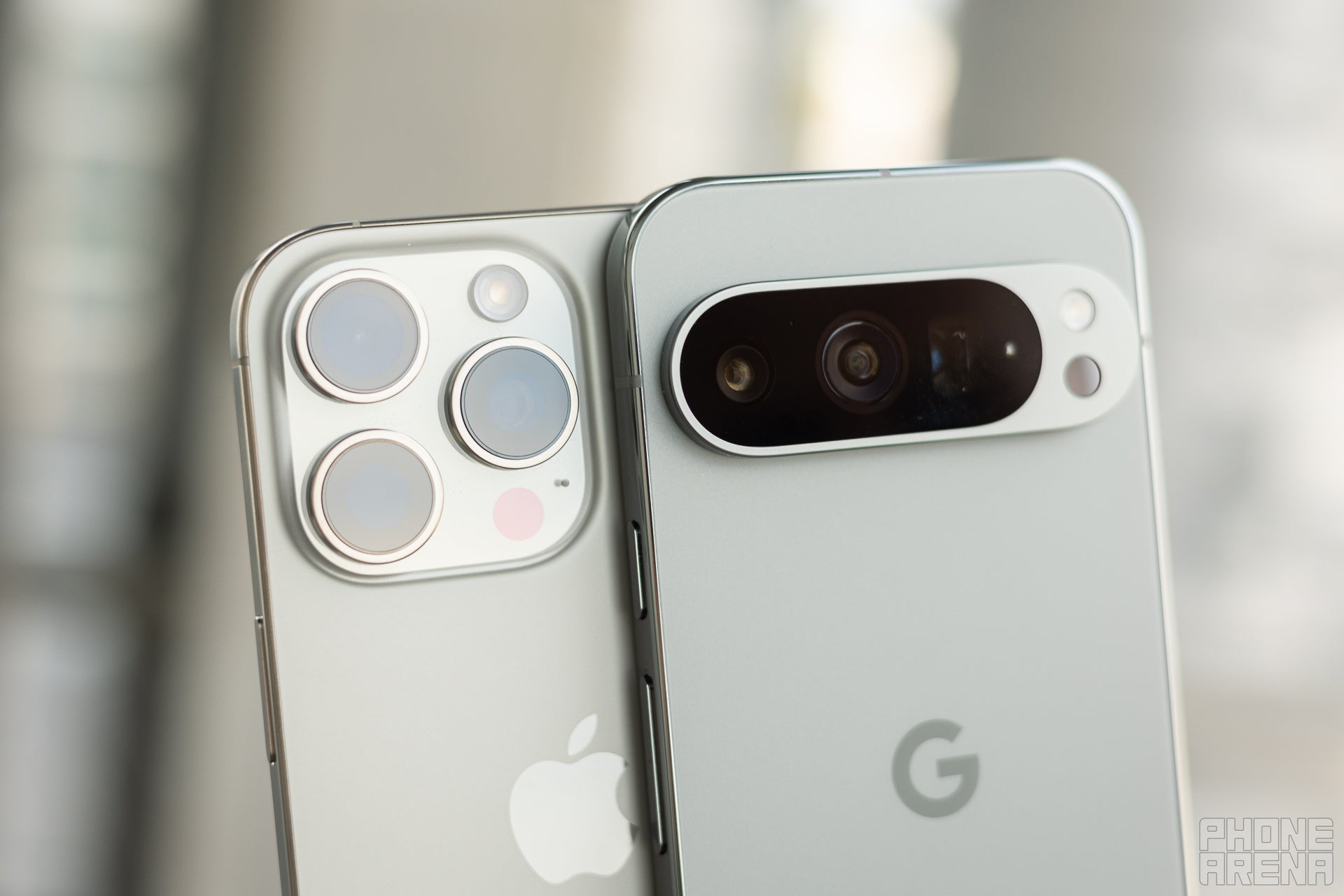
There's a new ultrawide camera inside the iPhone 16 Pro and Apple made a big fuss about it during the event. It's able to take hi-res photos, and also doubles as a macro camera. This 48MP snapper has finally taken the iPhone Pro models in the new, high-pixel-count world of ultrawide cameras. The main 48MP camera is the same as the one found on the iPhone 15 Pro series, which, albeit a bit disappointing, is not bad news.
The telephoto camera has been upgraded to the one we found on the Pro Max model last year. It features Apple's tetraprism tech and can do 5x optical zoom, making this year's Pro and Pro Max models closer than ever.
Last but not least, the all-new Camera Control button makes a debut on all of the iPhone 16 models. This is a capacitive button, capable of pressure-sensitive input and it mimics some of the functionality of the double-action shutter buttons we find on real cameras.
This sapphire crystal coated button also supports swipe gestures (controlling things such as zoom, ISO) and it works with third-party camera apps, not just the default iPhone camera app. That being said, the Camera Control button is not a programmable button and will only work with the iPhone 16 camera.
The Pixel 9 Pro features a very similar camera system to its predecessor in terms of lenses and capabilities. The device comes equipped with a 50MP main camera sensor, accompanied by a 48-megapixel ultrawide camera, and a 48MP periscope zoom lens with 5x optical zoom. Of course, post-processing algorithms will play a huge role in the final result and photo quality. Here come the samples.
Main Camera
These are actually quite close, much closer than the comparison with the Galaxy. Both the Pixel 9 Pro and the iPhone 16 Pro seem to have taken the warmth and smooth route for the post processing. The images look similar in tonality, detail, and dynamic range. However, it seems that the Pixel 9 Pro goes a bit overboard with the effect, and the samples from the iPhone look a bit more sharp.
When doing closeup shots, the Pixel 9 Pro displays a very shallow depth of field, even outside of Portrait mode, blurring the background heavily. The iPhone 16 Pro also has some of that but to a lesser degree. Overall, both look good, but the iPhone 16 Pro sample looks a bit more natural we would say.
Zoom Quality
The native optical zoom levels of both phones are almost the same, they list a 5x optical but it's relative to the focal length of the main camera. It's actually 5x24mm vs 5x25mm, so the difference is almost imperceivable.
The quality is very good in both images but here we like the Pixel 9 Pro sample better, it just looks more natural, while the iPhone 16 Pro exaggerates the lights and shadows too much.
Ultra-wide Camera
There's quite a bit of a difference in the ultrawide samples. The iPhone 16 Pro displays a sharp and a but brighter image but it's unnaturally sharp, almost jiggery. The Pixel 9 Pro in contrast snaps much softer and mellower samples, and putting those next to each other makes the difference much more obvious.
Front Camera
Samples from the front camera of both phones look very very close, both in tonality and overall details and sharpness. The skin color reproduction is great on both phones, and exposure is also spot on, but we think the Pixel 9 Pro does a tad better job at handling bright background sources of light.
Battery Life and Charging
Milliamp-hours don't tell the whole story
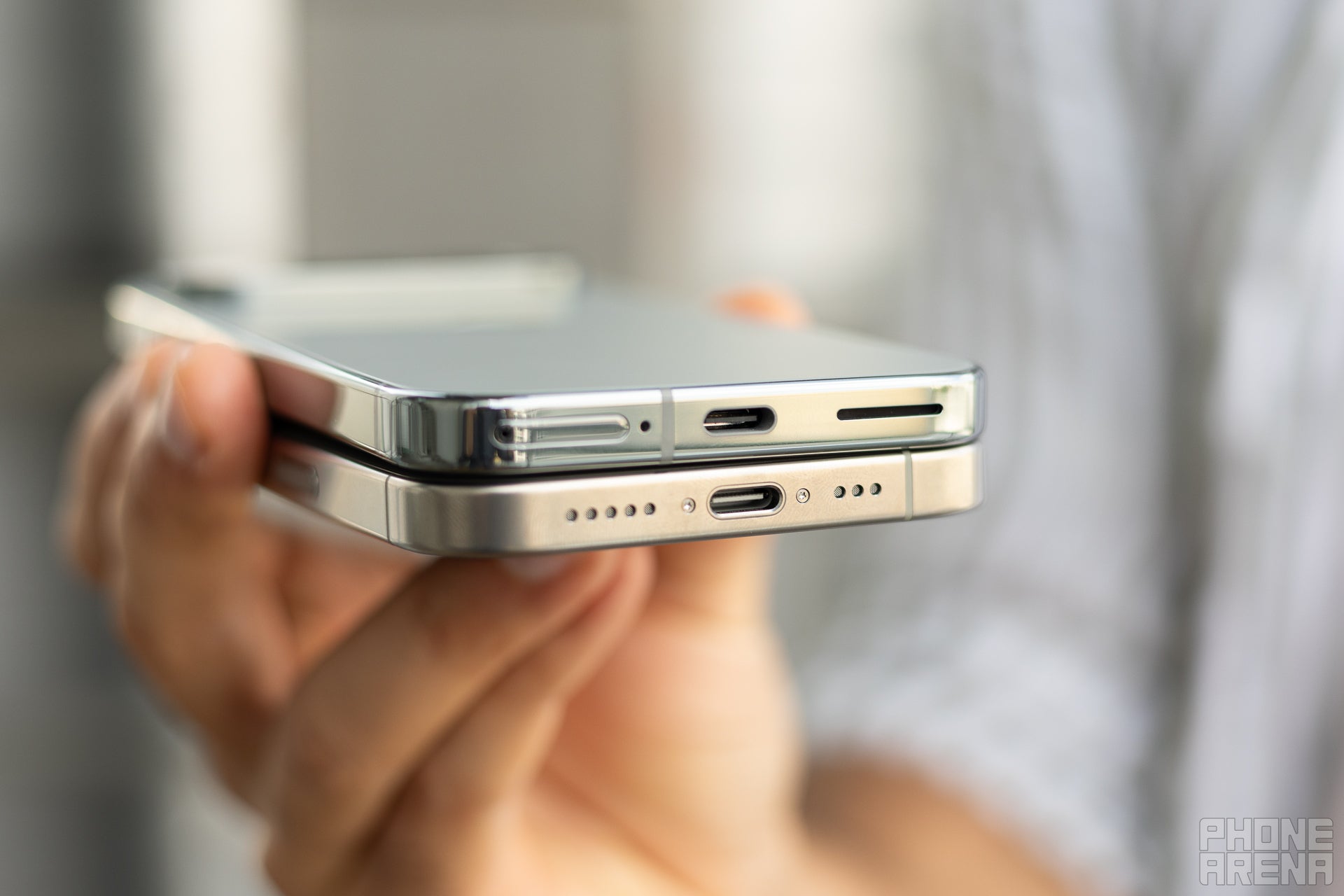
Normally, you can't argue with or cheat physics. Larger batteries equal longer autonomy. When it comes to iPhone devices, Apple has managed to somehow optimize them to perform on par with their Android counterparts with larger batteries.
For example, the iPhone 15 Pro Max comes with a 4,422mAh cell but performs on par, and sometimes better than the Galaxy S24 Ultra and its 5,000mAh battery. With that in mind, we might get very similar results from the iPhone 16 Pro and the Pixel 9 Pro.
The Apple phone comes with a 3,582 mAh battery, while Google managed to squeeze a 4700 mAh cell inside the Pixel 9 Pro body. Let's see what the benchmarks tell us.
Battery Life Comparison:
Even though the Pixel 9 Pro is the clear winner here, it's quite impressive that the iPhone 16 Pro managed to hold its ground given the 1,100 mAh difference in capacity. The Apple device fell short just 25 minutes in web browsing, and even managed to outperform the Pixel in the gaming part of the test.
Sadly, the charging situation remains largely unchanged when it comes to fast wired charging. The iPhone 16 Plus charges from 0 to 50% in roughly 30 minutes, which is not very impressive, to say the least.
The Pixel 9 Pro upgraded the somewhat slow charging of its predecessor and now offers 45W of wired charging, citing 0-55% in 30 minutes, which is better but still not blazing fast. Overall, despite the difference in charging speeds, both phones charge to full in about an hour and a half.
Specs Comparison
Here's a specs comparison table, you can see the full Google Pixel 9 Pro vs iPhone 16 Pro comparison on PhoneArena.
| Specs | Pixel 9 Pro | iPhone 16 Pro |
|---|---|---|
| Dimensions | 152.8 x 72 x 8.5 mm | 149.6 x 71.5 x 8.25 mm |
| Weight | 199 g | 194 g |
| Screen | 6.3-inch OLED 1-120Hz LTPO | 6.3-inch OLED 120Hz ProMotion |
| Processor | Google Tensor G4 (3nm) | Apple A18 Pro |
| RAM, Storage and Price | 16/128GB for $999 | 8/256GB for $999 |
| Cameras | 50MP main 48MP ultra-wide 48MP telephoto, 5x optical 10.5MP front | 48MP main 48MP ultra-wide 12MP telephoto 12MP front |
| Battery Size | 4,700 mAh | 3,582 mAh |
| Charging Speeds | 45W wired wireless | 27W wired MagSafe wireless |
Which one should you buy?
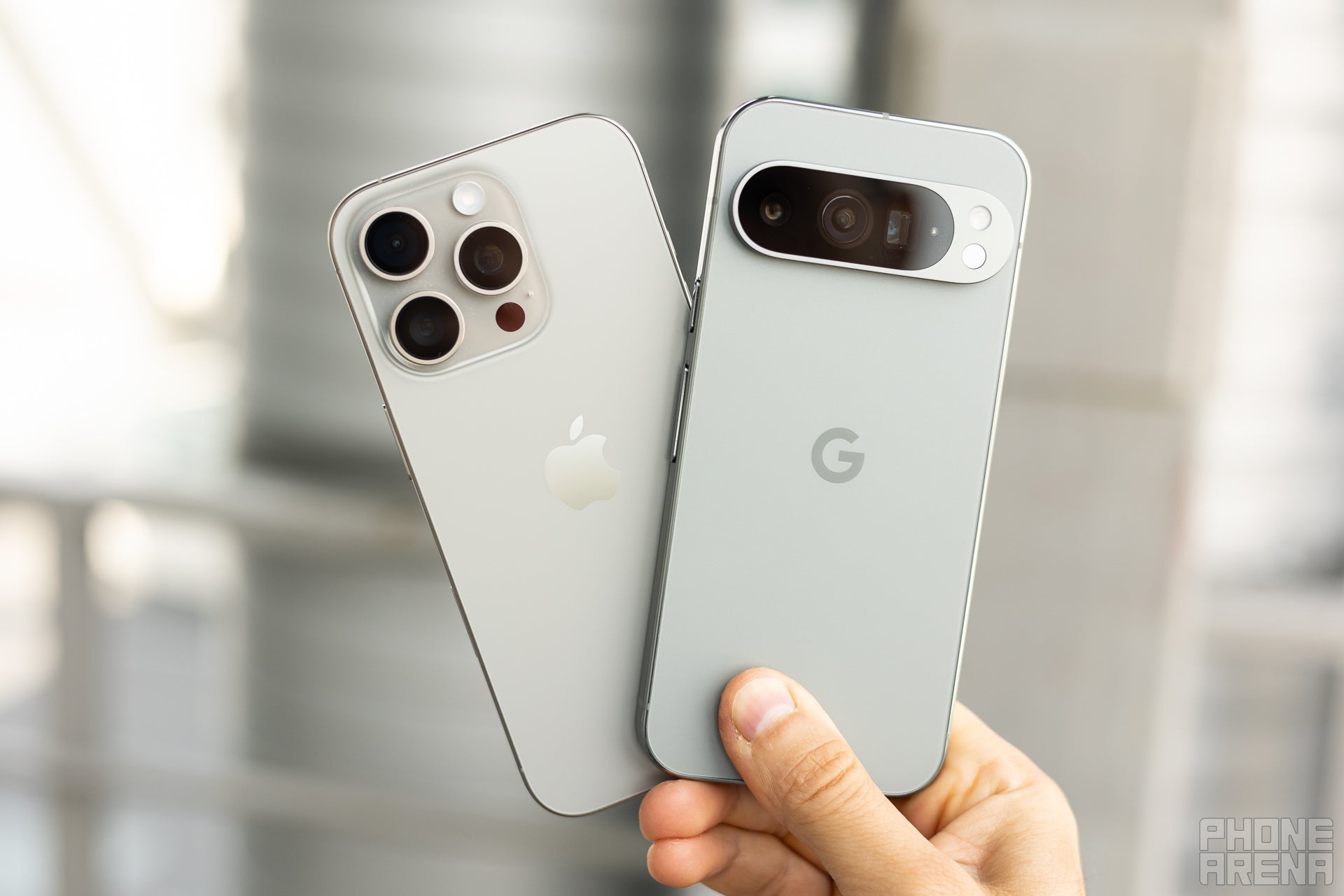
Well, here we are! Google has finally produced a flagship capable of giving Apple and Samsung some serious headaches. Not only does the Pixel 9 Pro look very similar in design and size to the iPhone 16 Pro, it also comes at the same price, and offers a very similar experience.
Granted, the Tensor is still far from the raw power of the A18 Pro, but the AI magic is already there, you don't have to wait months for that.
The screen of the Pixel 9 Pro is also one of the brightest out there (the brightest we've tested so far), and the camera system is at least on par with that on the iPhone (it's down to personal preference).
The battery life and charging are slightly better on the Pixel 9 Pro as well, and the seven years of software support is an added benefit. Both phones are great if you're new to the respective ecosystem, but if you want to switch, or upgrade, things are much more complex. What we can say is that you won't regret owning either of these.
Follow us on Google News



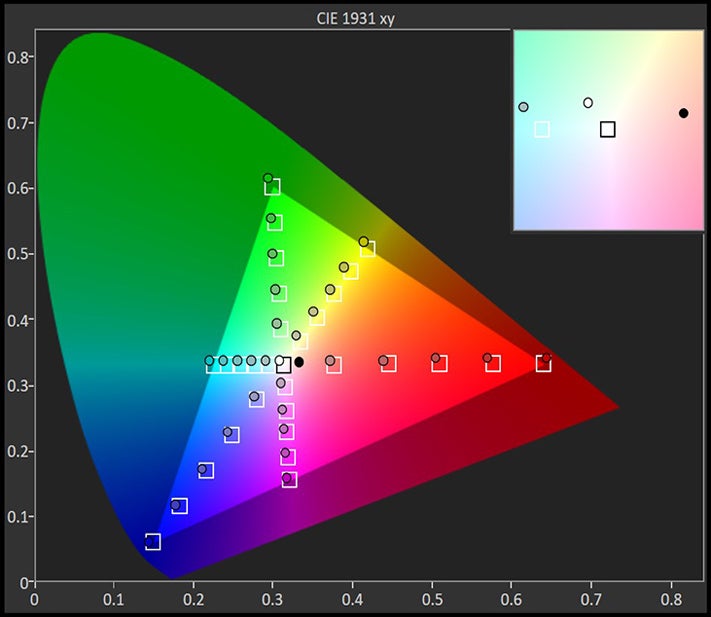





















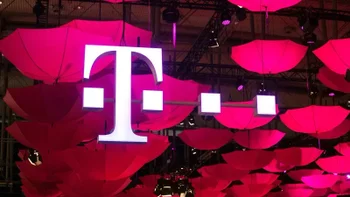


![A new Android bug is making it impossible to install new apps. Are you affected? [UPDATE]](https://m-cdn.phonearena.com/images/article/176703-wide-two_350/A-new-Android-bug-is-making-it-impossible-to-install-new-apps.-Are-you-affected-UPDATE.webp)

Things that are NOT allowed:
To help keep our community safe and free from spam, we apply temporary limits to newly created accounts: